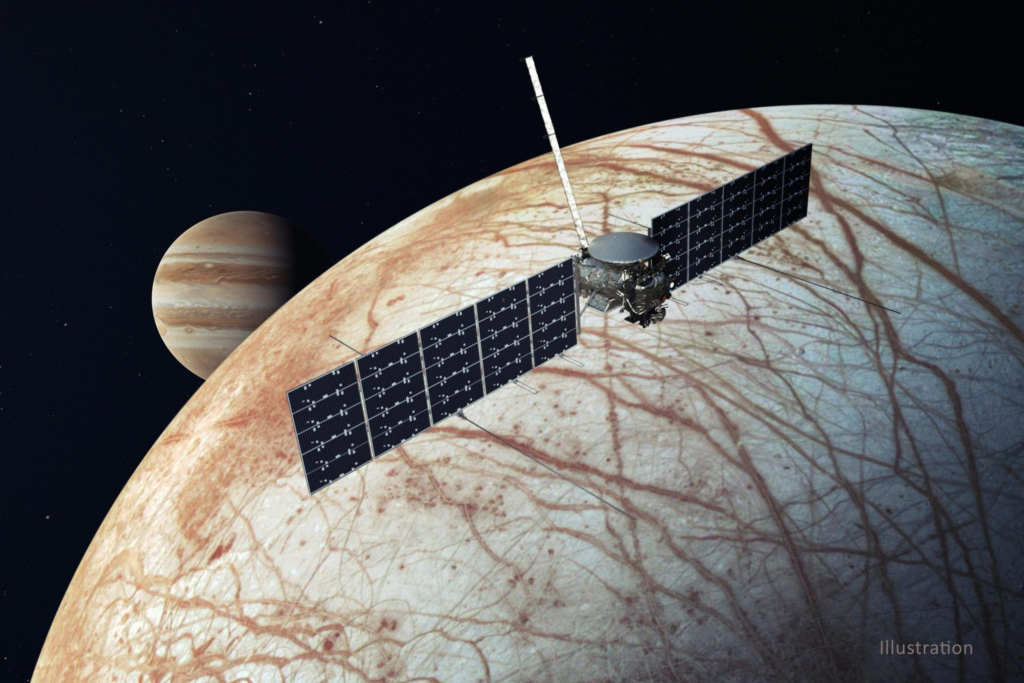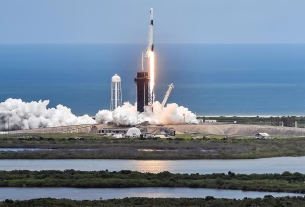Countdown to the Mission to Hunt for Alien life is underway as a spacecraft prepares to launch from Florida in just a few hours. Its destination is Europa, a mysterious moon orbiting the distant planet Jupiter. Beneath its icy surface lies the potential for a vast ocean containing twice the amount of water found on Earth. The Europa Clipper spacecraft will follow a European mission that launched last year. However, thanks to a cosmic piggyback strategy, it will overtake that mission and arrive first. While the spacecraft won’t reach Europe until 2030, the findings from this mission could significantly alter our understanding of life in our solar system. The Countdown to the Mission to Hunt for Alien Life promises to unveil exciting discoveries as we explore one of the most intriguing locations in our cosmic neighborhood.
A moon radiating with five times the brightness of our own
The Countdown to the Mission to Hunt for Alien life has reached a critical moment as the Europa Clipper launch, years in the making, faced delays due to hurricane Milton, which swept through Florida this week. The spacecraft was quickly moved indoors for safety. However, after engineers inspected the launchpad at Cape Canaveral for damage, they have now approved the lift-off scheduled for 12:06 local time (17:06 BST) on October 14.
Mark Fox-Powell, a planetary microbiologist at the Open University, emphasizes the mission’s significance: “If we discover life so far away from the Sun, it would imply a separate origin of life to the Earth.” He adds, “That is hugely significant, because if that happens twice in our solar system, it could mean life is really common.” Europa, located 628 million kilometers from Earth, is slightly larger than our moon, but that’s where the similarities end. If it were in our skies, it would shine five times brighter due to its water ice reflecting much more sunlight. Beneath its icy crust, which is up to 25 kilometers thick, there could be a vast saltwater ocean, along with chemicals that serve as the building blocks for simple life.
As the Countdown to the Mission to Hunt for Alien life continues, the potential discoveries from this mission could reshape our understanding of life beyond Earth.

The Countdown to the Mission to Hunt for Alien life began in the 1970s when scientists first realized that Europa might support life after observing water ice through a telescope in Arizona. Subsequent missions by the Voyager 1 and 2 spacecraft provided the first close-up images, followed by NASA’s Galileo spacecraft, which flew past Europa in 1995 and captured puzzling pictures. These images revealed a surface marked by dark, reddish-brown cracks—fractures that could contain salts and sulfur compounds potentially supporting life.
The Countdown to the Mission to Hunt for Alien life has also been fueled by recent observations from the James Webb telescope, which has taken images suggesting the presence of water plumes erupting 100 miles (160 kilometers) above Europa’s surface. However, none of these previous missions got close enough to Europa for a sufficient duration to truly understand its potential for hosting life. As we approach the Countdown to the Mission to Hunt for Alien life, the anticipation builds for what the upcoming Europa Clipper mission may uncover.
Soaring through jets of water
The Countdown to the Mission to Hunt for Alien life is underway as scientists anticipate that instruments aboard NASA’s Clipper spacecraft will map nearly the entire surface of Europa, collect dust particles, and fly through its water plumes. Britney Schmidt, an associate professor of Earth and atmospheric sciences at Cornell University in the U.S., played a key role in designing a laser onboard that will penetrate the moon’s icy surface. “I’m most excited about understanding Europa’s plumbing. Where’s the water? Europa has the ice version of Earth’s subduction zones, magma chambers, and tectonics—we’re going to try to see into those regions and map them,” she explains.
Her instrument, called Reason, was tested in Antarctica. However, unlike on Earth, all instruments on Clipper will face significant radiation exposure, which Prof. Schmidt identifies as a “major concern.” The spacecraft is expected to fly past Europa around 50 times, and during each flyby, it will encounter radiation equivalent to one million X-rays. “Much of the electronics are housed in a vault that’s heavily shielded to keep out radiation,” Prof. Schmidt notes.

The Clipper spacecraft is the largest ever built to explore a planet and has an extensive journey ahead. Traveling 1.8 billion miles, it will orbit both Earth and Mars to gain momentum toward Jupiter through what is known as the sling-shot effect. Since it cannot carry enough fuel to travel independently, it will leverage the gravitational pulls of Earth and Mars.
The spacecraft will overtake JUICE, the European Space Agency’s mission that will also visit Europa before heading to another of Jupiter’s moons, Ganymede. Once Clipper approaches Europa in 2030, it will activate its engines to carefully maneuver into the correct orbit.
Space scientists remain cautious when discussing the prospects of discovering life, emphasizing that there is no expectation of finding human-like creatures or animals. “We are searching for the potential for habitability, and you need four things: liquid water, a heat source, and organic material. Finally, those three ingredients must be stable over a long enough period for something to develop,” explains Michelle Dougherty, professor of space physics at Imperial College in London. They hope a better understanding of Europa’s ice surface will inform future landing site selections.
An international team of scientists from NASA, the Jet Propulsion Lab, and the Johns Hopkins Applied Physics Lab will oversee this mission. In an era where space launches occur nearly every week, this mission represents a unique endeavor. Professor Fox-Powell suggests, “There’s no profit being made. This is about exploration and curiosity, and pushing back the boundaries of our knowledge of our place in the universe.” As the Countdown to the Mission to Hunt for Alien life continues, anticipation builds for the discoveries that lie ahead.





